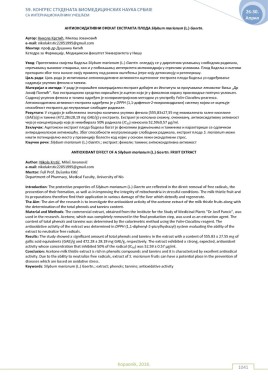Page 1047 - 59. КОНГРЕС СТУДЕНАТА БИОМЕДИЦИНСКИХ НАУКА СРБИЈЕ СА ИНТЕРНАЦИОНАЛНИМ УЧЕШЋЕМ
P. 1047
59. КОНГРЕС СТУДЕНАТА БИОМЕДИЦИНСКИХ НАУКА СРБИЈЕ 26-30.
СА ИНТЕРНАЦИОНАЛНИМ УЧЕШЋЕМ Април
АНТИОКСИДАТИВНИ ЕФЕКАТ ЕКСТРАКТА ПЛОДА Silybum marianum (L.) Gaertn.
Аутор: Никола Крстић, Милош Јовановић
e-mail: nikolakrstic22051995@gmail.com
Ментор: проф.др Душанка Китић
Kатедра за Фармацију, Meдицински факултет Универзитета у Нишу
Увод: Протективнa својства бадеља Silybum marianum (L.) Gaertn. огледају се у директном уклањању слободних радикала,
спречавању њиховог стварања, као и у побољшању интегритета митохондрија у стресним условима. Плод бадеља и његови
препарати због тога налазе своју примену код разних оштећења јетре коју детоксикују и регенеришу.
Циљ рада: Циљ рада је испитивање антиоксидативне активности ацетонског екстракта плода бадеља уз одређивање
садржаја укупних фенола и танина.
Материјал и методе: У раду је коришћен комерцијални екстракт добијен из Института за проучавање лековитог биља „Др
Јосиф Панчић“. Као екстракционо средство коришћен је ацетон који је у финалном кораку производње потпуно уклоњен.
Садржај укупних фенола и танина одређен је колориметријском методом уз употребу Folin-Ciocalteu реагенса.
Антиоксидативна активност екстракта одређена је у DPPH (1,1-дифенил-2-пикрилхидразил) систему којом се оцењује
способност екстракта да неутралише слободне радикале.
Резултати: У студији је забележена значајна количина укупних фенола (555,83±27,55 mg еквивалената галне киселине
(GAE)/g) и танина (472,28±28,19 mg GAE/g) у екстракту. Екстракт је испољио снажну, очекивану, антиоксидативну активност
чија је концентрација која је инхибирала 50% радикала (IC 50 ) износила 52,59±0,57 µg/ml.
Закључак: Ацетонски екстракт плода бадеља богат је фенолним једињењима и танинима и карактерише се одличном
антирадикалском активношћу. Због способности неутрализације слободних радикала, екстракт плода S. marianum може
имати потенцијално место у превенцију болести код којих у основи лежи оксидативни стрес.
Кључне речи: Silybum marianum (L.) Gaertn.; екстракт; феноли; танини; антиоксидативна активност
ANTIOXIDANT EFFECT OF A Silybum marianum (L.) Gaertn. FRUIT EXTRACT
Author: Nikola Krstić, Miloš Jovanović
e-mail: nikolakrstic22051995@gmail.com
Mentor: Full Prof. Dušanka Kitić
Department of Pharmacy, Medical Faculty, University of Nis
Introduction: The protective properties of Silybum marianum (L.) Gaertn are reflected in the direct removal of free radicals, the
prevention of their formation, as well as in improving the integrity of mitochondria in stressful conditions. The milk thistle fruit and
its preparations therefore find their application in various damage of the liver which detoxify and regenerate.
The Аim: The aim of the research is to investigate the antioxidant activity of the acetone extract of the milk thistle fruits along with
the determination of the total phenols and tannins content.
Material and Methods: The commercial extract, obtained from the Institute for the Study of Medicinal Plants "Dr Josif Pancic", was
used in the research. Acetone, which was completely removed in the final production step, was used as an extraction agent. The
content of total phenols and tannins was determined by the colorimetric method using the Folin-Ciocalteu reagent. The
antioxidative activity of the extract was determined in DPPH (1,1-diphenyl-2-picrylhydrazyl) system evaluating the ability of the
extract to neutralize free radicals.
Results: The study showed a significant amount of total phenols and tannins in the extract with a content of 555.83 ± 27.55 mg of
gallic acid equivalents (GAE)/g and 472.28 ± 28.19 mg GAE/g, respectively. The extract exhibited a strong, expected, antioxidant
activity whose concentration that inhibited 50% of the radical (IC 50 ) was 52.59 ± 0.57 μg/ml.
Conclusion: Acetone milk thistle extract is rich in phenolic compounds and tannins and it is characterized by excellent antiradical
activity. Due to the ability to neutralize free radicals, extract of S. marianum fruits can have a potential place in the prevention of
diseases which are based on oxidative stress.
Keywords: Silybum marianum (L.) Gaertn.; extract; phenols; tannins; antioxidative activity
Kopaonik, 2018.
1041

